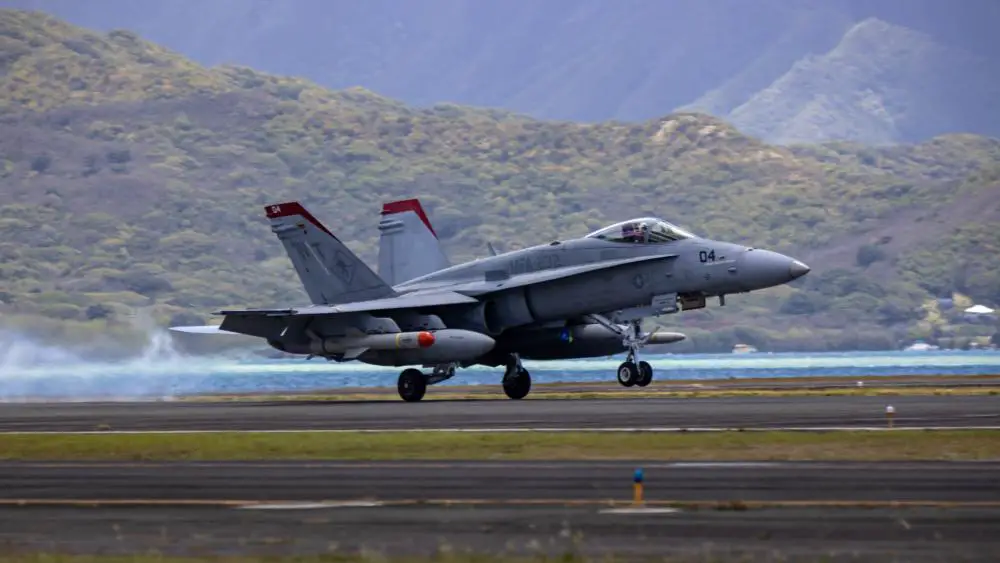F/A-18 Hornets from Marine Fighter Attack Squadron 232 (VMFA-232), Marine Air-Ground Task Force 7 (MAGTF-7) used Joint Direct Attack Munitions (JDAMs) against a ship, the ex USS Denver (LPD 9), during a sinking exercise (SINKEX) as part of Exercise Rim of the Pacific (RIMPAC) 2022. VMFA-232 coordinated the strike against the environmentally clean, decommissioned naval vessel in cooperation with the U.S. Navy and the U.S. Air Force. During SINKEX execution, four U.S. Marine Corps F/A-18 Hornets from VMFA-232 also fired High-Speed Anti-Radiation Missiles (HARM), followed by a Harpoon (AGM-84), and JDAMs. The F/A-18 is unique within the U.S. Marine Corps for its ability to employ a diverse array of air-to-surface and air-to-air weapons.
“With our Hornet’s JDAM employment against the USS Denver, the Marine Corps demonstrated our increasing arsenal of anti-ship capabilities,” said Brig. Gen. Joseph R. Clearfield, deputy commander, U.S. Marine Corps Forces, Pacific, and Fleet Marine Force commander for RIMPAC. It was a proud but bittersweet moment for me, having deployed aboard the USS Denver as a Marine Captain and company commander. But what a way for her to go out!”
“This SINKEX is a historic event for the Marine Corps and all the partner nations who contributed. The realistic training we’re doing at RIMPAC helps us advance multinational naval warfighting interoperability and competency. It also makes us more ready to rapidly respond to a global crisis or conflict,” said Col. David J. Hart, commanding officer, MAGTF-7. “This exercise allows us to test and advance our new weapon systems and to enhance our lethality, tactics, and security in the Indo-Pacific region.”

VMFA-232 also practiced finding and targeting the former USS Denver in conjunction with U.S. Navy maritime patrol and reconnaissance aircraft and U.S. Air Force MQ-9 Reapers, demonstrating the U.S. Marine Corps’ ability to integrate into a joint and combined command and control network anywhere. The firing of JDAMs by a Marine Corps F/A-18 against the former USS Denver demonstrates the Marine Corps’ ability to employ three different weapons systems in an anti-ship capacity. These include the Harpoon, the Naval Strike Missile (successfully employed against a ship during the Large-Scale Exercise 2021), and the JDAM. The technology the JDAM provides enhances our aviation combat element’s capabilities in eliminating maritime threats from peer adversaries and demonstrates the joint force’s adaptability to the future fight.
MAGTF-7 is the Marine Corps unit temporarily established by I Marine Expeditionary Force to participate in RIMPAC 2022, and is led by Col. Hart, commanding officer, 7th Marine Regiment, 1st Marine Division. It includes UH-1 Yankee and AH-1 Viper helicopters from Marine Light Attack Helicopter (HMLA) Squadron 169, as well as F/A-18 Hornet fighter/attack jets from Marine Fighter Attack (VMFA) Squadron 232. MAGTF-7 is organized as a unified air-ground, combined arms task force designed to carry out an array of combat operations. Former Navy vessels used in SINKEXs are prepared in strict compliance with regulations prescribed and enforced by the Environmental Protection Agency under a general permit the Navy holds pursuant to the Marine Protection, Research, and Sanctuaries Act. Each SINKEX is required to sink the hulk in at least 1,000 fathoms (6,000 feet) of water and at least 50 nautical miles from land. Surveys are conducted to ensure that no marine mammals or wildlife are harmed.
Prior to the vessel being transported for participation in a SINKEX, each vessel is put through a rigorous cleaning process, including the removal of all polychlorinated biphenyls (PCBs), transformers and large capacitors, all small capacitors to the greatest extent practical, trash, floatable materials, mercury or fluorocarbon-containing materials, and readily detachable solid PCB items. Petroleum is also cleaned from tanks, piping, and reservoirs. Twenty-six nations, 38 ships, three submarines, more than 170 aircraft, more than 30 unmanned systems, and 25,000 personnel are participating in RIMPAC from June 29 to Aug. 4 in and around the Hawaiian Islands and Southern California. The world’s largest international maritime exercise, RIMPAC, provides a unique training opportunity while fostering and sustaining cooperative relationships among participants, critical to ensuring the safety of sea lanes and security on the world’s oceans. RIMPAC 2022 is the 28th exercise in the series that began in 1971.

















